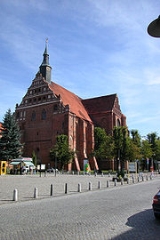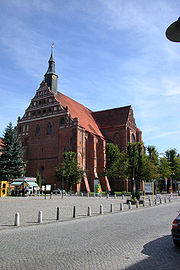
Bad Wilsnack
Encyclopedia
Bad Wilsnack is a town in the Prignitz
district, in Brandenburg
, Germany
. It is situated halfway between Berlin
and Hamburg
. Since 1928 it has been officially recognised as a spa town, before which time its name was simply Wilsnack. Bad Wilsnack is pronounced "But Vilsnuck".
 The town became a pilgrimage destination after being burned down in the 14th century during a raid by Heinrich von Bülow. It was believed that in 1383 some hosts
The town became a pilgrimage destination after being burned down in the 14th century during a raid by Heinrich von Bülow. It was believed that in 1383 some hosts
were found to have survived the fire, but had the appearance of being bloodied. The Holy Blood of Wilsnack
was authenticated when Bishop Dietrich Man
of Havelberg
went to consecrate the hosts as a precaution, and the central one overflowed with blood, according to later accounts.
Numerous pilgrims went to the town (which was rebuilt) to see the miraculous hosts; their revenues enabled the town to construct the large St. Nikolai Church for their worship, a larger building than otherwise needed in the parish. The pilgrims who went to Wilsnack bought pewter trinkets to indicate that they had reached the site. These emblems were often in the form of three hosts connected together. Seen in numerous medieval paintings, the tokens have turned up in archaeological digs from the area. The numbers of pilgrims were said to rival those to Santiago de Compostela
in Spain. Despite controversy, the pilgrimages continued until 1558, when the hosts were destroyed during the Protestant Reformation.
The story of the bleeding hosts was depicted in a series of woodcuts made during the Middle Ages. The town used the image on emergency money which it printed and issued during the inflation crisis of the 1920s (Notgeld).
Prignitz
Prignitz is a Kreis in the northwestern part of Brandenburg, Germany. Neighboring are the district Ludwigslust-Parchim in Mecklenburg-Western Pomerania, the district Ostprignitz-Ruppin in Brandenburg, the district Stendal in Saxony-Anhalt and the district Lüchow-Dannenberg in Lower...
district, in Brandenburg
Brandenburg
Brandenburg is one of the sixteen federal-states of Germany. It lies in the east of the country and is one of the new federal states that were re-created in 1990 upon the reunification of the former West Germany and East Germany. The capital is Potsdam...
, Germany
Germany
Germany , officially the Federal Republic of Germany , is a federal parliamentary republic in Europe. The country consists of 16 states while the capital and largest city is Berlin. Germany covers an area of 357,021 km2 and has a largely temperate seasonal climate...
. It is situated halfway between Berlin
Berlin
Berlin is the capital city of Germany and is one of the 16 states of Germany. With a population of 3.45 million people, Berlin is Germany's largest city. It is the second most populous city proper and the seventh most populous urban area in the European Union...
and Hamburg
Hamburg
-History:The first historic name for the city was, according to Claudius Ptolemy's reports, Treva.But the city takes its modern name, Hamburg, from the first permanent building on the site, a castle whose construction was ordered by the Emperor Charlemagne in AD 808...
. Since 1928 it has been officially recognised as a spa town, before which time its name was simply Wilsnack. Bad Wilsnack is pronounced "But Vilsnuck".
Overview

Hospitality
Hospitality is the relationship between guest and host, or the act or practice of being hospitable. Specifically, this includes the reception and entertainment of guests, visitors, or strangers, resorts, membership clubs, conventions, attractions, special events, and other services for travelers...
were found to have survived the fire, but had the appearance of being bloodied. The Holy Blood of Wilsnack
Holy Blood of Wilsnack
The Holy Blood Wilsnack were three allegedly miraculous hosts, which survived a fire in 1383 that burned the church and village to the ground. The relics became the destination of medieval religious pilgrimages to Bad Wilsnack, Germany for nearly two centuries. Revenue from the many pilgrims...
was authenticated when Bishop Dietrich Man
Dietrich Man
Dietrich Man, known as Dietrich II, was Bishop of Havelberg from 1370 to 1385.The Man family, though not noble, were prominent in the Prignitz, which lay within the Diocese of Havelberg, and closely connected with the local nobility. Dietrich's grandfather Johann Man married, first, a widow of Ivan...
of Havelberg
Bishopric of Havelberg
The Bishopric of Havelberg was a Roman Catholic diocese founded by King Otto I, King of the Germans, in 946. The diocese was suffragan to the Archbishopric of Magdeburg. Its most famous bishop was Anselm of Havelberg. Its seat was in Havelberg in the Northern March and it roughly covered the...
went to consecrate the hosts as a precaution, and the central one overflowed with blood, according to later accounts.
Numerous pilgrims went to the town (which was rebuilt) to see the miraculous hosts; their revenues enabled the town to construct the large St. Nikolai Church for their worship, a larger building than otherwise needed in the parish. The pilgrims who went to Wilsnack bought pewter trinkets to indicate that they had reached the site. These emblems were often in the form of three hosts connected together. Seen in numerous medieval paintings, the tokens have turned up in archaeological digs from the area. The numbers of pilgrims were said to rival those to Santiago de Compostela
Santiago de Compostela
Santiago de Compostela is the capital of the autonomous community of Galicia, Spain.The city's Cathedral is the destination today, as it has been throughout history, of the important 9th century medieval pilgrimage route, the Way of St. James...
in Spain. Despite controversy, the pilgrimages continued until 1558, when the hosts were destroyed during the Protestant Reformation.
The story of the bleeding hosts was depicted in a series of woodcuts made during the Middle Ages. The town used the image on emergency money which it printed and issued during the inflation crisis of the 1920s (Notgeld).

